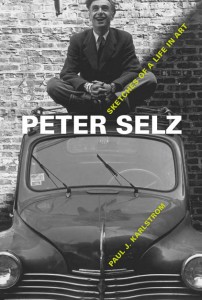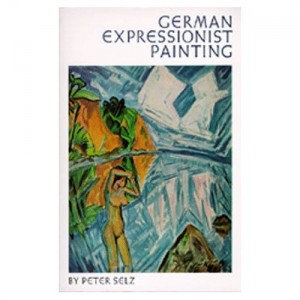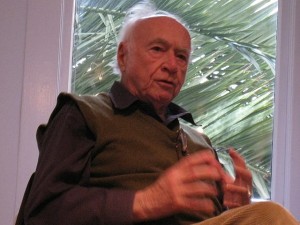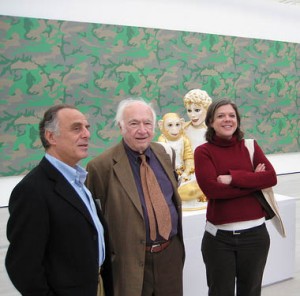Biographies of artists are everywhere, but how often does one find a biography of an art historian? At a recent reading and book signing at the Jack Rutberg Gallery, I discovered such a book, Paul Karlstrom’s new biography on art historian, curator, and university professor Peter Selz. Better yet, it was an opportunity to meet both Karlstrom and Selz, all in an evening’s entertainment.
That this event was held at the Jack Rutberg Gallery did not surprise me. Rutberg and Selz have had a long relationship; in fact, it was Rutberg who originally introduced Selz to Hans Burkhart at his studio. After many conversations with Rutberg, I’m convinced that his passion for art and awe of accomplished artists coincided exactly with those of Selz.
Although the reader learns a great deal about Selz’s career in the book, his inner self remains relatively obscure. Karlstrom acknowledges as much, stating that, “…the resulting portrait will surely be incomplete.” He has based this biography primarily on oral interviews and Selz’s own revelations. Karlstrom also states that, “he [Selz] managed to create an image that suits him…[and] ignored or suppressed certain qualities and behaviors,” which is an interesting statement given Selz’s fame for candor. Fortunately, the reader gets much information on Selz from Karlstrom’s other interview sources, making Selz more translucent but never transparent.
The book covers his early life in Germany as a Jew living in Munich, mentored by his grandfather Julius Drey who owned an art and antiques gallery. He was wisely sent to live in New York in 1936 at age17. Prior to joining the US Army during World War II, Selz hooked up with his second mentor, Alfred Stieglitz, besides managing to work a few years at, of all places, a brewery filled with anti-Semitic German Nazi sympathizers.
The GI Bill financed his degrees from the University of Chicago, after which he published his well-known book, German Expressionist Paintingin 1957. He then taught at the Chicago Institute of Design and continued to form bonds with working artists such as Leon Golub. This would remain the touchstone of his approach to art history, that is, the basis of understanding art would always be artist-centered.
While teaching at Pomona College, he impressed Alfred Barr and Rene d’Harnoncourt who then established him as curator of modern painting and sculpture exhibitions at MoMA, a formidable promotion. Selz put on many exhibitions that included such artists as de Kooning, Dubuffet, Bacon, Giacometti, Voulkos, Lebrun, Diebenkorn, Rothko, Tinguely, Beckmann, Nolde, and one of my all time favorites, Oliveira.
Characteristics of Selz encompassed eclecticism, efficiency, and reliability. Always independent minded, he never shrank from expressing his viewpoint. These qualities helped him champion artists whose work he felt possessed substance or what could be termed artistic gravitas. Conversely, he held strong opinions against art that, in his opinion, pandered to the superficial and the gimmicky. As the art winds of the ‘60’s shifted dramatically, Selz found himself out of sync with MoMA as well as a number of new artists constantly popping up. It was not surprising that when he once asked Frank Stella for the time, Stella responded, “It’s time for you to leave.”
Selz left MoMA to become the permanent founding director of Berkeley’s University Art Museum. Once again he put on innovative exhibitions featuring artists such as Rene Magritte and Jules Pascin. He mounted an exhibit entitled “Funk,” and staged various performances such as Anna Halprin’s nude dancers and music by another of my favorites, Steve Reich. On top of all this, he brought the Hans Hofmann collection and Ruben’s “The Road to Calvary” to the Museum.
With Selz’s new directorship came a professorial position at Berkeley. As usual, he was an enthusiastic instructor, but once again he found his passionate involvement with artists and their works at odds with most of Berkley’s art historian professors who considered historical research as a clinical analytical process best tested in an ivory tower. During this period, Selz took full advantage of Berkeley as a center of the sexual revolution of the ‘60’s. He was always open about his particular views on sex and marital infidelities (he is currently married to his fifth wife). Unfortunately, this biography does not give us much detail on the women in his life, nor would it satisfy any desire for salacious details of his energized libido.
The biography briefly touches on Selz’s decision to testify as an expert witness for Frank Lloyd (Marlborough Gallery) against the heirs of Mark Rothko for a fee of $20,000 (in 1970 dollars). Lee Seldes describes him in her fabulous book, The Legacy of Mark Rothko, “In his rumpled seersucker suit ” playing “…with a battery-powered mini-fan, as Ross [attorney] attempted to knock holes in both his credibility and his estimates.”
Now in his nineties, Selz concentrates his energy on visiting, being a curator, and writing catalogues for numerous galleries. His influence continues unabated, exemplified by the new Metropolitan Museum of Art’s curator Sheena Wagstaff who recently stated, “I think it’s very important that what we present at the Met is artist-centered,” words straight out of the Selz lexicon. Peter Selz’s legacy is well established, and Paul Karlstrom’s book allows us a peek into that secret, unique life of art historians.
Copies of the book are available from the Jack Rutberg Gallery.






As the author of this book, I’m pleased to read your attentive and insightful account. Your appreciation of Selz and his story is what I was seeking. Actually though, despite your comment, one does learn a lot about the wives he felt were more than mere mistakes (yes, that’s in the book). Thailia, his first wife and mother of their two daughters even speaks to us courtesy of taped dialogues from the mid 1990s shared by, Gabrielle, the younger daughter. Peter and Thalia agreed to meet twice, in NYC and then in Berkeley, and attempt to understand what went wrong for them. She was inclined to blame it on MoMA. His present marriage to fifth wife Carole has over the past three decades enabled Selz to continue his impressive work with limited domestic duties and concerns. In March we celebrated with Peter his 93rd bithday. He has yet another innovative exhibition opening soon at Meridian Gallery in San Franciso. Organized with fellow Meridian board member, Sue Kubly, the show is entitled “The Painted Word” and it features painting and other works of art by mainly Beat era poets (April 28-June 9). As his biographer, I am still trying to find the source of the creative life force that energizes him. I will need to tap into that soon. The rest of us should be so fortunate. Thank you. PJK
My comment is above.